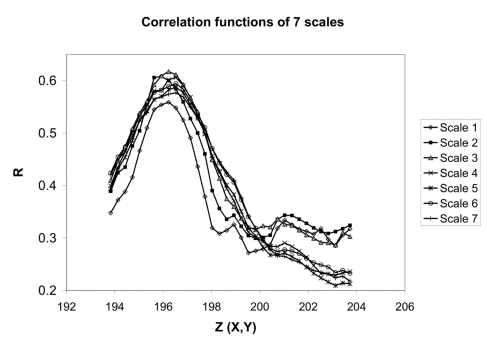41 response scales how many points and what labels
› pmc › articlesGlobal Rating of Change Scales: A Review of Strengths and ... The patient responds to the question by marking a scale that measures the degree of improvement or deterioration. When designing this scale, the assessor must first consider how many points or response options there should be. This number may range from the simplest 3-point scale 56 to a 101-point scale 5. Having too few points risks losing ... PDF Likert Scale Examples for Surveys - Iowa State University Three-Point Scales: More than I would like About right . Less than I would like Too Harsh About right . Too Lenient Too Strict About right . Too Lenient Too heavy About Right . Too light Too much About right . Too little Extremely Moderately . Not at all . Four-Point Scales: Most of the time Some of the time Seldom ...
Survey Scale: Definitions, Types + [Question Examples] A rating scale is a type of survey response scale that allows respondents to match specific qualitative values with different assertions, products, or features. With a rating scale, you simply answer the survey question by picking one of the rating options on the scale. ... Likert scales commonly have a 3-point, 4-point, or 5-point scale structure.

Response scales how many points and what labels
mymarketresearchmethods.com › types-of-data-nominalTypes of Data & Measurement Scales: Nominal, Ordinal ... Dec 28, 2021 · These four data measurement scales (nominal, ordinal, interval, and ratio) are best understood with example, as you’ll see below. Nominal. Let’s start with the easiest one to understand. Nominal scales are used for labeling variables, without any quantitative value. “Nominal” scales could simply be called “labels.” The influence of labels associated with anchor points of ... - PubMed The influence of labels associated with anchor points of Likert-type response scales in survey questionnaires J Appl Meas . 2011;12(4):370-86. ... research has accumulated which demonstrates that verbal and numeric labels associated with item's response categories in such questionnaire may influence substantially the way in which respondents ... User Experience Rating Scales with 7, 11, or 101 Points: Does It Matter? Van Beuningen et al. (2014) compared verbal label items with five response options and 11-point numerical items with the endpoints labeled. They found some distributional differences but no correlational differences with related variables. They reported more missing data for 11-point items (~2.5%) than for 5-point items (~.75%).
Response scales how many points and what labels. journals.sagepub.com › doi › fullAssessment Scales for Sexual Disorders—A Review - Sandeep ... Jul 10, 2020 · The scale has a variety of items with different response scales and formats. This scale has good psychometric properties. Golombok Rust Inventory of Marital State (GRIMS) 90: A 28-item questionnaire that evaluates the quality of the relationship between a married couple or a couple in a live-in relationship. It is considered being sensitive to ... A Search for the optimum feedback scale Thus when defining an optimum response scale it is important to consider scales which are frequently used. The Mayflower organisation2, which regularly implements surveys, has recommended four five-point scales found to be especially effective: 1) Far too much, too much, about right, too little, far too little. 15 Common Rating Scales Explained - MeasuringU The classic Likert item uses a 5-point response scale, but you can use 7, 9, or other points, too. (Although someone will have a strong opinion about the "right" number of steps.) Because the response scale is about agreement, be sure items are phrases participants can agree or disagree to. labs.psych.ucsb.edu › collins › nancyRevised Adult Attachment Scale (Collins, 1996) - UC Santa Barbara There have been many developments in the field since my original scale was published, and you may find that newer scales – such as Brennan, Clark, & Shaver’s (1988) Experiences in Close Relationships scale (ECR) – are better suited to your needs. I have included some references that will help you locate information on these newer measures.
The 4,5, and 7 Point Likert Scale + [Questionnaire Examples] 3 Point Likert scale is a scale that offers agree and disagree as to the polar points along with a neutral option. Like the 2-point scale, the 3 point scale is also used to measure Agreement. Options will include: Agree, Disagree, and Neutral. 6 Points Likert Scale A 6 point Likert scale forces choice and gives better data. Survey Response Scales - Answer Format and Types of Questions - Explorable Three-point, five-point, and seven-point scales are all included in the umbrella term "rating scale". A rating scale provides more than two options, in which the respondent can answer in neutrality over a question being asked. Examples: 1. Three-point Scales Good - Fair - Poor Agree - Undecided - Disagree Extremely- Moderately - Not at all Survey Rating Scales to Guide Survey Respondents Effectively Five point scales are most popular followed by seven point scales. These scale ranges tend to work best. Beyond a 7 point scale participants have trouble responding the same way if they repeated the survey, so we recommend staying away from anything above 7 points. Here is an example of a 5 point Likert Rating Scale: Strongly disagree Disagee EOF
Choosing Response Scale Labels and Length by P Darbyshire · 2004 · Cited by 50 — There has been much debate over the optimal format for scales, particularly in regard to two key issues. - the labelling of points and the overall length of ...10 pages Verbal and Numeric Labels for Response Scales - SCB by C O'Muircheartaigh · 1995 · Cited by 67 — which demonstrates that the construction of the response scale may ... questions; the response scales carried numeric labels on all the scale points.13 pages A classification of response scale characteristics that affect data ... In total, they considered more than 280 possible choices, among which 40 choices are related to the design of the scale and belong to 17 characteristics. Table 2 in Appendix provides the list of response scales' characteristics and the choices considered by these authors. › blog › three-tips-forYour Guide to Rating Scale Questions in 2022 - Qualtrics The scale's points should map as closely as possible to the underlying idea (construct) of the scale. Also, the scale should give enough points to differentiate respondents from one another as much as validly possible. It should be easy to interpret the meaning of each scale point - i.e. the meaning of scale points should be interpreted ...
How to Label Response Scale Points in Your Survey | Qualtrics Here's an example of a seven-point bipolar scale where, through the use of appropriate modifiers, all responses are mutually exclusive of one another. Finally, to ensure that you get the highest-quality data possible, keep these four guidelines in mind as you practice labeling response scales:
What Is the Best Response Scale for Survey and Questionnaire Design ... points use for their survey and questionnaire. Taken as a whole this study suggests using of seven-point rating scale and if there is a need to have respondent to be directed on one side, then six-point scale might be the most suitable. Key Words Response Scale, Rating Scale, Attitude Scale, Liker Scale, Scaling Method, Response Rate,
Sample Likert Scales - Marquette University Frequency - 7 point. 1 - Never. 2 - Rarely, in less than 10% of the chances when I could have. 3 - Occasionally, in about 30% of the. chances when I could have. 4 - Sometimes, in about 50% of the chances when I could have. 5 - Frequently, in about 70% of the. chances when I could have. 6 - Usually, in about 90% of the chances I ...
peltiertech.com › multiple-time-series-excel-chartMultiple Time Series in an Excel Chart - Peltier Tech Aug 12, 2016 · The chart below right uses Days for its base unit. Labels appear every month, so they are centered on the slots for the first point of each month. Data points also appear on the first of each month, and the slots for all the other days of the month lie empty, with the series line connecting points across the empty slots.
the effect of labeling and numbering of response scales on the by G Moors · Cited by 102 — random, it is of great concern to any survey researcher. Response bias is a well-known source of non-random error and Likert type rating scales have shown ...44 pages
5 Point Likert Scale Analysis, Interpretation and Examples There are 3-point Likert scales, 4-point Likert scales, 5-point, 6-point, 7-point, and even 9-point Likert scales. We get your question. Why are there so many and are they all used for the same purpose? Like we already mentioned, Likert scales are generally used to measure opinion concerning a subject.
Survey Response Scales: How to Choose the Right One - CXL Survey response scales can be embedded in the survey (e.g., 1-5, 1-10, etc.), chosen via a drop-down menu, or included as part of the survey language. No matter how you choose to display the scale, the default ranges affect the precision of your data. For example, if a survey asks your age, a default range of 20-25 instead of 20-30 has ...
Should All Scale Points Be Labeled? - MeasuringU For example, coming up with labels for each of the points on the eleven-point Likelihood to Recommend item would likely be impractical; endpoints and a neutral label may be all that can be done. But labeling each response option for five- and seven-point scales is practical and a fairly common practice.
What is a Likert Scale? Definition, Examples, and Usage - SurveyLegend Most researchers agree that the best Likert scales are the 5-point and 7-point varieties. This simply refers to how many responses the person has to choose from. Most Likert scales you see are going to be odd-numbered. They will have an equal number of positive and negative responses on either side of a neutral response.
PDF Typical Survey Response Scales - STLHE n Bipolar scales (Disagree to Agree) have a maximum reliability and validity at 7 points whereas unipolar scales (e.g., Not True at all to Completely True) have a maximum reliability and validity at 5 points (Krosnick & Fabrigar, 2003) n Numeric labels seem to increase confusion rather than verbal labels (Krosnick & Fabrigar, 2003)
User Experience Rating Scales with 7, 11, or 101 Points: Does It Matter? Van Beuningen et al. (2014) compared verbal label items with five response options and 11-point numerical items with the endpoints labeled. They found some distributional differences but no correlational differences with related variables. They reported more missing data for 11-point items (~2.5%) than for 5-point items (~.75%).
The influence of labels associated with anchor points of ... - PubMed The influence of labels associated with anchor points of Likert-type response scales in survey questionnaires J Appl Meas . 2011;12(4):370-86. ... research has accumulated which demonstrates that verbal and numeric labels associated with item's response categories in such questionnaire may influence substantially the way in which respondents ...
mymarketresearchmethods.com › types-of-data-nominalTypes of Data & Measurement Scales: Nominal, Ordinal ... Dec 28, 2021 · These four data measurement scales (nominal, ordinal, interval, and ratio) are best understood with example, as you’ll see below. Nominal. Let’s start with the easiest one to understand. Nominal scales are used for labeling variables, without any quantitative value. “Nominal” scales could simply be called “labels.”













Post a Comment for "41 response scales how many points and what labels"